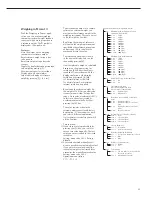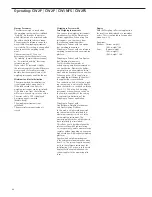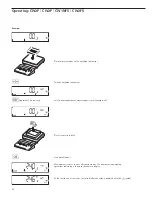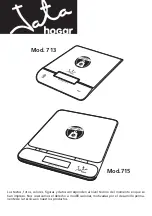
Display
The result of a measurement is shown
either as a weight value or in relation
to the target. You can toggle between
these two display modes by pressing
w
.
– Weight display mode:
The main display always shows the
weight value, even if the value is
outside the tolerance range.
The bar graph is displayed with symbols
indicating lower limit, target and upper
limit. It shows a logarithmic display of
the current load if the weight is any-
where from 0 to the minimum load, and
a linear display for weights beyond that
range.
The LEDs indicate the following:
Yellow: weight value >
upper tolerance limit
Green: weight value is
within tolerance
Red:
weight value <
lower tolerance limit
If no LED lights up:
– the application is not completely
initialized, or
– the weight value is outside
the checkweighing range
(see menu item 4.2)
– the weighing instrument has
not stabilized
– Tolerance limit display mode:
As “Weight display mode" above,
with the exception that:
–
LL
is shown on the main display
if the weight value is lower than
the target, and
–
HH
is shown on the main display
if the weight value is higher than
the target
Digital Input/Output Interface
The Checkweighing application supports
the digital input/output interface.
There are 4 control lines, or outputs,
which are activated as follows
(also refer to the diagram):
– Lighter
– Equal
– Heavier
– Set
The “SET" output normally changes
its voltage level when the load is near
the target weight. Alternatively, you can
assign the “Ready-for-use" function to
this port (menu item 4.3.2).
Under menu item 4.4, you can define
whether these control ports are
– inactive (4.4.1)
– always active (4.4.2)
– active at stability (4.4.3)
– active within the check range, or
– active at stability within the check range
For example, you can use this function
to show the weighed or measured result
on a simple external indicator, similar to
the 3 LEDs on the Combics 2.
All data output ports have a high
voltage level when:
– the application has not been initialized,
– the weighing instrument is not at
stability and one of the “at stability…"
parameters, (4.4.3 or 4.4.5) is selected,
or
– the weight is not within the check
range (4.4.4).
Digital I/O Interface
“SET" control line: set and control lines:
Always active/Active at stability
Digital I/O Interface
“SET" control line: set and control lines:
active within checkweighing range/
Active within checkweighing range at
stability
Output line specifications:
– In the inactive state, the levels are set to
“high:” > 3.7 V/+4 mA
– In the active state, the levels are set to
“low:” < 0.4 V/–4 mA
!
The output lines are not short-circuit
proof!
36
Operating: CW2P | CW2P | CW1NFS | CW2FS
Target weight
Checking Range
Lower
limit
Upper
limit
30 %
170%
Equal
Set
Lighter
Heavier
Operative
Target weight
Lower
limit
Upper
limit
30 %
170%
Equal
Set
Heavier
Lighter
Operative
Checking Range
Summary of Contents for CH1NE
Page 102: ...CH Platform Dimensions Scale Drawings CH G CH E 102 ...
Page 108: ...108 ...
Page 109: ...109 ...
Page 110: ...110 ...
Page 111: ...111 ...
Page 112: ...112 ...
Page 113: ...113 ...
Page 114: ...114 ...
Page 115: ...115 ...
Page 116: ...116 ...
Page 117: ...117 ...
Page 118: ...118 ...
Page 120: ......
















































